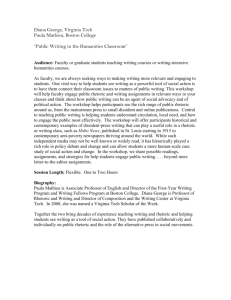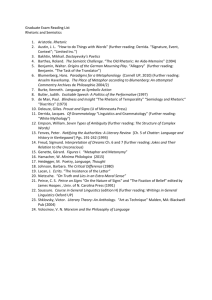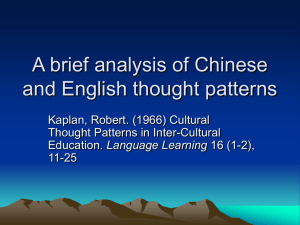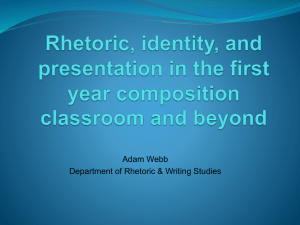Document Version of Critical Reflective Essay - sites@gsu
advertisement
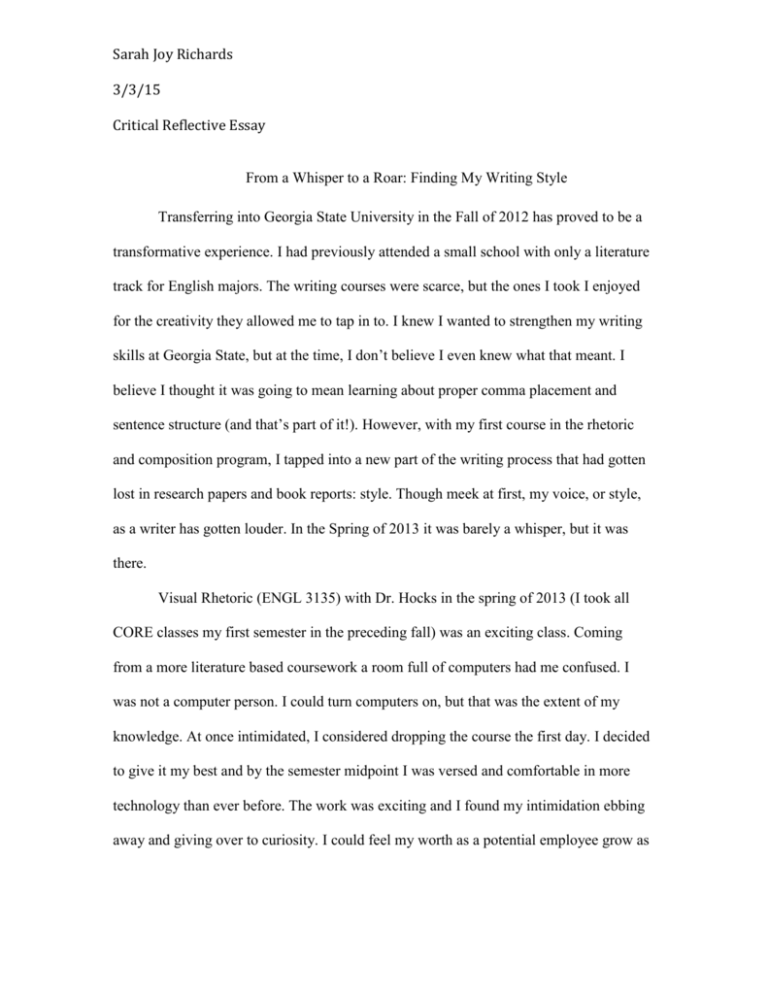
Sarah Joy Richards 3/3/15 Critical Reflective Essay From a Whisper to a Roar: Finding My Writing Style Transferring into Georgia State University in the Fall of 2012 has proved to be a transformative experience. I had previously attended a small school with only a literature track for English majors. The writing courses were scarce, but the ones I took I enjoyed for the creativity they allowed me to tap in to. I knew I wanted to strengthen my writing skills at Georgia State, but at the time, I don’t believe I even knew what that meant. I believe I thought it was going to mean learning about proper comma placement and sentence structure (and that’s part of it!). However, with my first course in the rhetoric and composition program, I tapped into a new part of the writing process that had gotten lost in research papers and book reports: style. Though meek at first, my voice, or style, as a writer has gotten louder. In the Spring of 2013 it was barely a whisper, but it was there. Visual Rhetoric (ENGL 3135) with Dr. Hocks in the spring of 2013 (I took all CORE classes my first semester in the preceding fall) was an exciting class. Coming from a more literature based coursework a room full of computers had me confused. I was not a computer person. I could turn computers on, but that was the extent of my knowledge. At once intimidated, I considered dropping the course the first day. I decided to give it my best and by the semester midpoint I was versed and comfortable in more technology than ever before. The work was exciting and I found my intimidation ebbing away and giving over to curiosity. I could feel my worth as a potential employee grow as 2 I learned about these new technologies and how online content should be presented to different audiences. In the first piece I chose for my portfolio, I created a Storify project with an accompanying essay about the pros and cons of the “Don’t Be That Guy” ad campaign. I chose this piece because I believe it is a strong work in its own right; however, in comparison with my other portfolio pieces, it shows that my training was still in its early stages. Looking at the work now, on the other side of my coursework, I notice areas where I would have changed the design of the content to be easier for the audience to read. For example, I did not do a good job of “chunking” text in the finished product, which is essential to ensure viewers do not just scan large portions of text. My project had a target audience of ages 18-24 (the same as the campaign itself) and the tone I took on in the work reflects my first attempt at finding a writing style that was relatable to that audience, yet sophisticated enough to be taken seriously. It took another semester before I started to find that voice. This portfolio piece is one of the most personal in my portfolio. When I took Electronic Writing and Publishing (ENGL 3120) in the Fall of 2013 one of my assignments was to maintain a blog throughout the semester on a single topic. I chose to do my blog on living with Cystic Fibrosis (CF). Talking about such a personal issue, I wanted my tone to be relatable to those who didn’t have CF, and show a side of CF that I wasn’t seeing in my research of other CF-related blogs: humor. What I had originally intended for a small class to read, resulted in being read my medical students, doctors, and even Emory researchers and scientists the following spring. I was invited to speak at Emory University about my blog as well. Seeing my writing humanize the disease for 2 3 researchers was a surreal experience. They each said that the style of my writing was what kept them reading. It was the ultimate compliment but that style wasn’t achieved easily. Each post on my blog was a balancing act! In coming up with material for the blog I would try to think of CF patient daily life, or recent events in my health that caused me to roll my eyes in annoyance. I’d write it out and then find everything I found humorous about the situation. I wanted to ensure that through my writing others could find that humor too even in the most serious of situations discussed on the blog. In my constant writing and rewriting process I started to find a specific voice. My voice. I was finding my writing style. When I read through this class blog I don’t feel I was trying to stretch my writing style like I did in my portfolio piece for Visual Rhetoric. The style of this blog feels very organic and the design is much more reader friendly. I learned to be more concise in my posts, chunk text, and balance text with visual images. These are all components my courses have taught me make up a strong blog. While other courses in the program taught me how to interpret or rework existing content, Electronic Writing and Publishing taught me to how to create my own. The department also taught me to market myself as a potential employee by broadening my knowledge of technologies and providing me with internships. In the Fall of 2013 as my ENGL 4500 course, I was an intern for South Atlantic Modern Language Association (SAMLA). At this point, I had yet to take Document Design, but my main tasks for the internship were to update multiple documents for the upcoming SAMLA85 conference. 3 4 Under the supervision of Dr. Diana Eidson I spent the semester editing the documents down to essential information. Next, I researched and compared SAMLA’s style guide with what I had been taught in my classes so far. Sometimes, new challenges would arise as I worked on the online versions of the documents. The style guide for all SAMLA documents didn’t transfer online in a way that followed the same design rules I had been taught. When I hit moments like this I went to Dr. Eidson for advice. We would talk through the pros and cons of differing from the style guide in the name of design. The finished products are much easier to read and both versions have more prominent and organized headings for getting information to session chairs at the next SAMLA conference. My internship allowed me to gain experience in a work environment and to manage multiple projects on a deadline. It also taught me how to brainstorm and collaborate with coworkers towards a common goal. In addition to these skills, Dr. Eidson also had each intern produce four business writing samples so I was able to produce a resume, cover letter, memo, and official letter with feedback and critiques. Again, I was slowly learning how to market my degree through my experiences as an undergraduate. The rhetoric and composition program has been amazing about explaining how the work done in class is a marketable skillset for employment. At this point in my degree, I was learning what different paths my writing could take me down. However, I knew I still lacked in some areas, like strong research skills. The following semester I had the chance to study genres of writing that let me strengthen my research. 4 5 My annotated bibliography for Dr. Holmes’ ENGL 3100 is my next portfolio piece. I wanted a work in my portfolio that showed a strong area of research. In this course we discussed many different genres of writing and practiced writing in a few of them. This assignment in particular called for creating an annotated bibliography for my portion of research for a group project about teaching ESOL students. I was very intimidated about doing an annotated bibliography but by the time I finished with this piece I felt comfortable in the genre. The steps I had to take to complete this assignment made me a stronger as a researcher. Through this work I was able to see how doing an annotated bibliography forced me to do more than scan my sources. I was able to make a stronger claim in my final presentation for the group project because I was well versed in the subject matter. Learning to evaluate the source I was reading for credibility and relation to my topic were valuable skills because it helped maintain the integrity of my research. Since working on this piece, I’ve had to create other annotated bibliographies for classes. I no longer feel intimidated by them. This taught me not to allow something new to break down my confidence. My most recent piece at GSU is my sonic rhetoric response for ENGL 4320. Learning to attune myself to sonic rhetoric in senior seminar class has been a unique experience. I’ve enjoyed the process of constantly asking myself, “What am I hearing?” and “how does it affect me?” I’m learning to listen to music as noise first, music later. Songs are just layering of sounds. I feel that sonic rhetoric and visual rhetoric are all about slowing down your own mind and questioning why it jumps to conclusions in a split second when it hears a noise. Learning how connected I am with sounds has caused 5 6 me to be much more self aware in different environments. The piece I chose for my portfolio has a breakdown of a song and the rollercoaster of sensations and emotions one can encounter even when we don’t recognize it. Though still new to sonic rhetoric I’m excited to see how much I’ve learned by the end of the semester. For my final piece, I wanted to include my research essay from my English 3050 with Dr. Lopez. The reason I wanted to include this research paper is because I feel it is my strongest piece of academic writing. In the same way that my Visual Rhetoric piece shows the areas where my writing was weakest at the start, this piece shows how my rhetoric and composition coursework at Georgia State has strengthened those areas and challenged me to grow as a writer, rhetorician, and critical thinker. In the paper, I was to write about rhetoric in some form. I chose to research how social media was affecting the way we ingest our daily news. From there, my research narrowed to how breaking news came across Twitter. I learned at this point in my project that I would have to narrow my research even further in order to create a strong argument. In class we were encouraged to discuss our concerns with our peers. In past courses, peer review had often failed to help in terms of how to make my papers stronger in content, only stronger in grammatical mechanics. In this class, however, I found that the group discussion really helped stimulate more critical thinking about my paper. As I was discussing my topic and its relation to rhetoric with my peers, I noticed I was learning to discuss rhetoric on a higher level. All of my classmates were. As a result, peer review quickly turned into a useful tool. The key was the broader knowledge of rhetoric itself. 6 7 When I read through this paper, I feel that my argument is supported in a very organized way. All of my points are stated along with their supporting evidence, as well as counterpoints for the main argument. I wanted to discuss how Twitter has affected the world of journalism in both positive and negative ways. I argue that journalistic credibility might be sacrificed with the introduction of breaking news on Twitter, but that in some instances, Twitter allows reporting to be done in areas where traditional journalists could not go. This work is a milestone in the road to strengthening a weakness in my writing: maintaining a strong argument throughout my paper. This was a paper I really enjoyed working on. Since turning this paper in for a grade, I have continued to revise it and submit it to academic conferences. At the beginning of my coursework at Georgia State, I didn’t feel motivated to push myself past what was asked of me. Here, at the end of my coursework, I’m planning paper topics with the idea of where I can take them beyond the classroom. Seeing that change along with so many others has been immensely rewarding. My skills as a researcher have increased exponentially, my online writing is better formatted for the webpages, and my ability to market myself as an English major has expanded. Through all of these mediums I feel that my personality still comes though. Writing style is how the writer conveys who they are. I’ve discovered and gained more confident in my writing style. Through my rhetoric and composition coursework at Georgia State, my voice as a writer has swelled from a whisper, to a roar. 7 8 8

